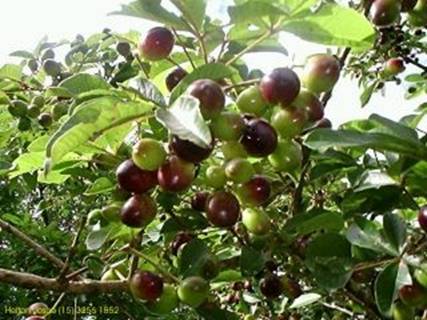VITEX CYMOSA
POPULAR NAMES: Azeitona do mato, Jaramantaia and Tarumã do Brejo.
LAMIACEAE

INDIGENOUS NAME: Jaramantaia comes from the Tupi-Guarani and means "tree from which the water rises, with fruit pulp adhered the seed", the Indians in Amazonia are relating this tree to the legend of Yará or Mother of water.
Origin: Atlantic Forest from Minas Gerais to Rio Grande do Sul and the Pantanal in Mato Grosso and Mato Grosso do Sul and in Amazonia, Brazil
Characteristics: The tree is deciduous (loses all the leaves in winter) is from 4 to 10 meters (13 to 33 feet) tall, when isolated and in the middle of the forest it will reach 20 meters (67 feet) in height. The crown has the shape of the cup and the branches have the shape of V. The bark is gray and dark and loose themselves in longitudinal strips. The leaves are compound and with 3 to 5 leaflets like fingers, a petiole or stem 6 to 12 cm in length. Each leaf measures 5 to 10 cm long by 4 to 6 cm wide. The flowers are appeared in inflorescence heights (cluster ending in a terminal flower) with approximately 8 to 20 small flowers of 1.5 cm in diameter in the shape of cup (sternum shell), campanulate (in form of bell) and lobate (with 5 or cuttings indentation) of yellowish green color, they appear as the tree is naked before the budding of the leaves.
Planted in the site of Frutas Raras: November 2004, not yet bloomed and fruited.
Tips for cultivation: Fast growing tree that resists low temperatures (to -4°C (25°F)), and grows at altitudes up to 600 m (2,000 feet). The soil may be deep, wet, and of neutral pH, with sandy or clay formation (red soil). You must plant at least 2 plants for better production. The plant begins to fruit in the age of 4 years.
Propagation: The seeds are cylindrical, measuring 0.8 cm in length and 0.4 cm in diameter and lose viability in less than 60 days and should be sown as soon as harvested in beds or individual packages containing organo-clay substrate and left in an environment with approximately 30 % of shade, the germination rate is less than 50 % and occurs in 40 to 120 days, depending on climatic conditions. The rapid growth of seedlings is getting ready for planting after 7 months.
Planting: Can be planted in full sun and in forests with large trees well spaced. Space of 6 x 6 m (20 to 20 feet). Add to the hole 1kg of lime pit and 1 kg of ash and 8 liters of organic matter. Water every fifteen days during the first 3 months, then only water is absent at the time of bloom.
Cultivating: Make only forming pruning of the crown and remove branches that were appeared at the base of the trunk. Fertilize with organic compost, may be (6 liters) poultry litter + 50 g of NPK 10-10-10 doubling that amount every year until the 3rd year.
Uses: The fruit can be consumed in-kind, or used to make the kind of sweet guava or liquor. The tree can be used in reforestation, because its fruits are food for wildlife and timber is of good quality.
Flowering in the site of Frutas Raras: Not yet observed.
Fruiting in the site of Frutas Raras: Ocurrs in the nature in February and early March.
Back to the seedlist (English) or back to Lamiaceae (Portuguese)